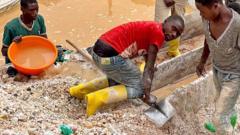In a rare glimpse into the inner workings of the Rubaya mine, the M23 rebel group in eastern Democratic Republic of Congo (DRC) allowed BBC access to one of the world's vital coltan mining sites. With more than 10,000 miners working tirelessly across its expanse, the mine is essential for the production of smartphones and other electronic devices. Miners, with shovels and sacks, are constantly engaged - a reflection of their relentless search for a livelihood.
Patrice Musafiri, the site supervisor since M23 seized control last April, shared that the terrain is challenging, demanding careful navigation. Nonetheless, for many miners, this grueling work is a lifeline. “When we are deep in the mines, temperatures are high, and there are harmful gases, but I am grateful. Through mining, I have saved for my dowry and now have a family,” said miner Peter Osiasi.
The Rubaya mine is located in the lush Masisi Hills, approximately 60km from Goma, and contains 15% of the world’s coltan supply. Its wealth has attracted both local miners and international investors, especially amid recent political shifts, such as the U.S.-brokered ceasefire aimed at ending decades of regional instability.
Amid intricate local politics involving ethnic tensions and armed rebel groups, the M23 has carved out control over large chunks of the eastern DRC, including Goma. Allegations of Rwandan support for the M23 persist, although both the rebels and Rwandan officials firmly deny them. The U.S. involvement appears heavily tied to mineral wealth in the area, raising questions about potential future investments from American companies in a region long dominated by Chinese interests.
During a brief visit to the mine, the BBC observed a coordinated effort among miners, with no armed men present, a sign of the M23's planned security measures. Musafiri pointed out improvements made in safety, regulation, and dispute resolution within mining operations. While some miners appreciate the stability brought by the M23, the issue of low wages continues to plague their livelihoods. Osiasi emphasized, “Business is going well, but we are paid very little.”
As the broader peace process unfolds, hopes for better conditions at Rubaya hang in balance. Many miners call for both an end to conflict and higher wages, wishing for a brighter future. “My plea to our leaders is to ensure peace in our area,” urged Osiasi. “I also appeal to mine owners to raise our pay because it’s very little.”
With ongoing negotiations, the fate of Rubaya mine and its miners remains uncertain, underlying the complex web of economic opportunity and conflict that epitomizes the region.






















